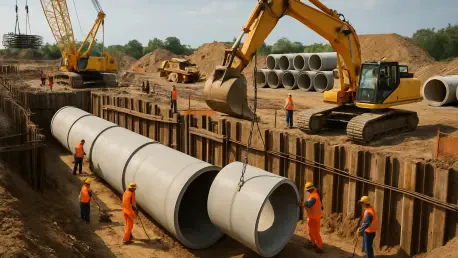Diving into the dynamic world of construction and infrastructure, we’re thrilled to sit down with Luca Calarailli, a seasoned expert in the field with a deep-rooted passion for design, architecture, and the innovative use of technology. With years of experience under his belt, Luca offers a unique perspective on the recent acquisition of Crescent Constructors by Zachry Construction, a deal that’s making waves in the water infrastructure sector. In this conversation, we explore the strategic thinking behind the acquisition, the growing importance of water projects, and the broader trends shaping the construction industry today.
Can you walk us through the key reasons behind Zachry Construction’s decision to acquire Crescent Constructors at this particular moment?
Absolutely. Timing in acquisitions like this is everything, and for Zachry, the market conditions aligned perfectly. There’s a growing demand for infrastructure upgrades, especially in the water sector, driven by aging systems and new environmental challenges. Zachry saw an opportunity to strengthen its position by bringing Crescent’s specialized expertise on board. It’s also about long-term growth—Zachry aims to diversify its portfolio and become a leader in high-demand areas like water infrastructure, and this move is a significant step in that direction.
What is it about the water construction market that has captured Zachry’s focus right now?
Water infrastructure is a critical need across the country. We’re seeing increased public and private investment in projects to address everything from outdated systems to emerging contaminants. For Zachry, this sector represents both a business opportunity and a chance to make a real impact. Crescent Constructors brings a strong track record in municipal and industrial water projects, which complements Zachry’s existing capabilities and allows them to tackle more complex, large-scale initiatives together.
How do you anticipate this acquisition will affect Crescent Constructors’ operations on a day-to-day basis?
From what I understand, continuity is a priority. The 100 employees staying on in Plano will likely keep their core roles, maintaining the local expertise that made Crescent valuable in the first place. However, there might be some integration in terms of processes or technology to align with Zachry’s broader systems. As for identity, it seems Crescent will retain its name for now, which helps preserve client relationships and brand recognition, though full integration could happen down the line as synergies develop.
Looking ahead, what types of projects do you envision Zachry and Crescent collaborating on in the coming years?
I expect a strong focus on water infrastructure projects, particularly those addressing municipal needs like treatment plants or distribution systems. There could also be industrial projects where water management is key. Beyond that, their combined expertise positions them to take on initiatives that solve pressing societal issues—like ensuring clean, safe water access—which is something leadership at both companies has highlighted as a driving force.
With challenges like ‘forever chemicals’ or PFAS in water infrastructure, how do you see Zachry approaching these environmental concerns?
Tackling contaminants like PFAS requires a mix of innovation and practical know-how. Zachry, with Crescent’s input, will likely invest in advanced filtration technologies and treatment methods that target these persistent chemicals. There’s also a need for collaboration with regulators and communities to meet evolving standards. Crescent’s experience in municipal water projects will be invaluable here, as they’ve likely already navigated similar challenges and can bring proven solutions to the table.
There’s been a noticeable uptick in mergers and acquisitions in construction since the COVID-19 pandemic. How do you view this trend from an industry perspective?
It’s a double-edged sword. On one hand, the increase in deals—up significantly in recent years—signals confidence and a drive to consolidate expertise and resources, which can lead to better outcomes on complex projects. On the other hand, it comes with risks like cultural clashes or overextension during economic uncertainty. For Zachry, navigating this acquisition amid a tough economic climate shows strategic resilience, likely through careful planning and a clear focus on complementary strengths with Crescent.
Leadership at Zachry has pointed to transportation and water infrastructure as major growth areas. Can you expand on why these sectors hold so much potential?
Both sectors are tied to fundamental needs. Transportation infrastructure—think roads, bridges, and transit systems—is essential for economic growth and connectivity, and there’s a huge backlog of projects needing attention. Water infrastructure, as we’ve discussed, is equally critical due to aging systems and new environmental threats. Together, these areas offer a chance for companies like Zachry to not only grow but also address vital public needs, creating value for communities and clients alike.
What’s your forecast for the future of water infrastructure development in the construction industry over the next decade?
I’m optimistic but realistic. We’re likely to see a surge in investment as governments and private entities prioritize resilient, sustainable systems. Technology will play a huge role—think smart water management and advanced treatment solutions. But challenges like funding gaps and regulatory hurdles will persist. For companies like Zachry and Crescent, the key will be staying agile, embracing innovation, and building partnerships to tackle these complex issues head-on. I believe the next ten years could redefine how we approach water infrastructure if the industry commits to bold, forward-thinking strategies.









